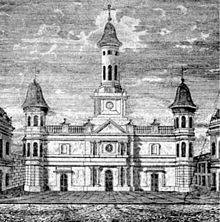New Orleans Founded on this Date!
The City of New Orleans was founded on this date in 1718. French immigrants Jean-Baptiste Le Moyne de Bienville named the new settlement for Philippe II, the Duke of Orléans.
Jean-Baptiste Lapaise de Védrines (the progenitor of all Vidrines in LA) was born just a few years earlier (1712) in Ste. Livrade, France. 25 years after New Orleans was founded, he arrived there from France aboard the royal ship La Charente with newly-appointed Governor Pierre de Rigaud, Marquis de Vaudreuil on May 8, 1743. He was a lieutenant in the garrison of French Marines stationed in New Orleans, where he remained until he was sent to Ft. Chartres in IL in the Spring of 1751.
This is an interesting description of the city of New Orleans by a French Marine, Jean-Benard Bossu (1720-1792), who arrived in New Orleans about the same time Jean-Baptiste Lapaise de Védrines was leaving. It gives an indication of the life of the city as it was when Jean-Baptiste Lapaise de Védrines arrived and during the years he lived there:
“The city of New Orleans is situated on the banks of the Mississippi, one of the greatest rivers of the world, since it flows through more than twenty-four hundred miles of known country. Its pure and delicious waters serve a country of an hundred and twenty miles, in the middle of which are a number of homes which present a delightful spectacle on both banks. The owners of these homes enjoy in abundance all the pleasures of the chase, of fishing, and of all the other delicacies of life.
In New Orleans the streets are well arranged and today this city is greater and more thickly populated than it has ever been. Its inhabitants are of four sorts, Europeans, Americans, Africans or negroes, and Mongrels. The Mongrels are those who were born of Europeans and of those natives of the country whom we call savages.
They describe Creoles as those who were born of a Frenchman and a Frenchwoman, or a Frenchman and a European.
The Creoles are in general very brave, grand, and haughty. They are disposed towards the cultivation of the arts and sciences, but as they do not have the opportunity of following the teachings of good masters here, the rich and well meaning parents do not hesitate to send their children to France as the first school of everything in the world. They do this particularly in order that the respective sexes might properly learn their positions in the world.
New Orleans and Mobile are the only cities where they do not speak in patois. Here the French that is spoken is correct. The negroes are brought from Africa. They are used in cultivating the soil, which is excellent for the cultivation of indigo, tobacco, rice, maize, and of sic sugar cane, for all of which there are very well managed plantations.
The Capuchins were the first priests to arrive in New Orleans. They came as missionaries in 1723. Their superior was the first Curé of the Parish, and these good religious devoted themselves solely to the affairs of their ministry.
The Jesuits, two years later, established themselves in Louisiana; these splendid diplomats discovered the secret of exploiting the rich land of the colony, which they obtained through their political moves.
The Ursulines came about the same time as the Jesuits, or a little later. These pious women, whose zeal is assuredly most praiseworthy, devoted themselves to the education of the young girls. They also received the orphans into their community, and for this service the King gave them a pension of fifty crowns for each orphan. They were also in charge of the military hospital.
When the colony was established, a tribe known as the Chitimachas lived on a stream to the west of New Orleans, which bore their name.”
– Travels through that part of North America formerly called Louisiana, Jean Benard Bossu, 1771, pp. 194-195

